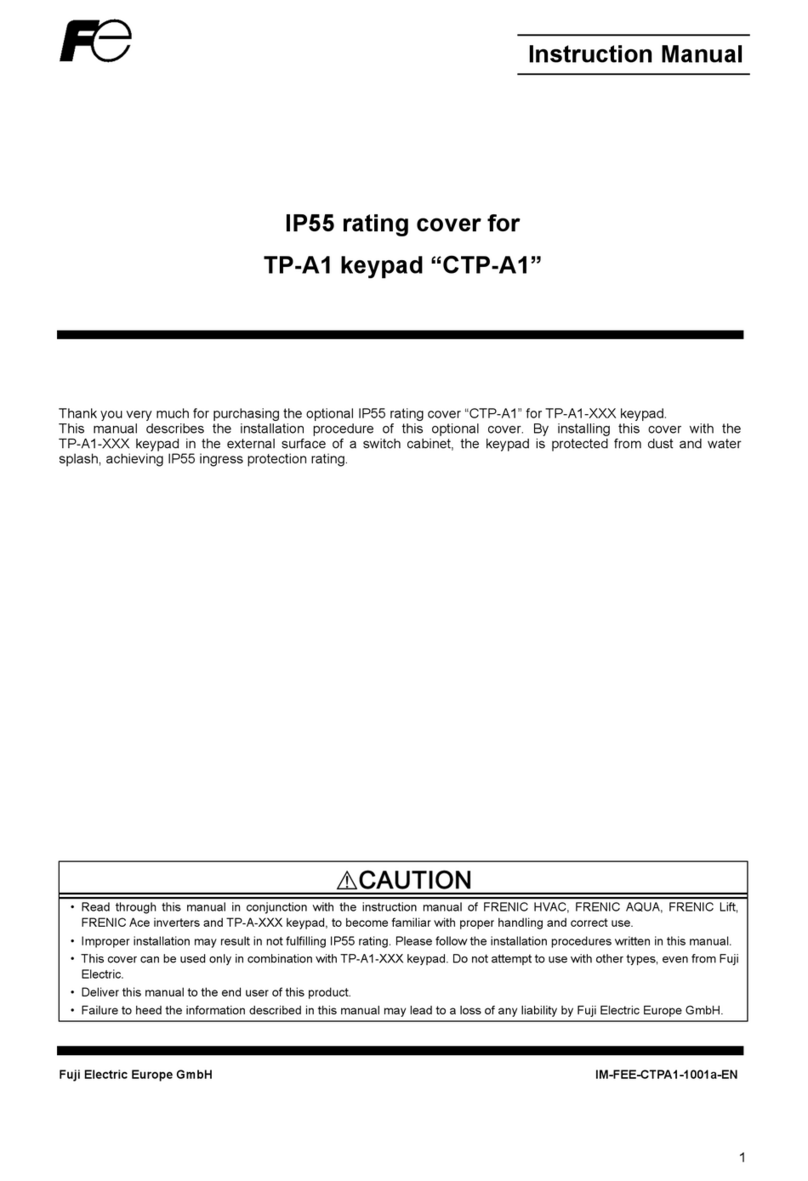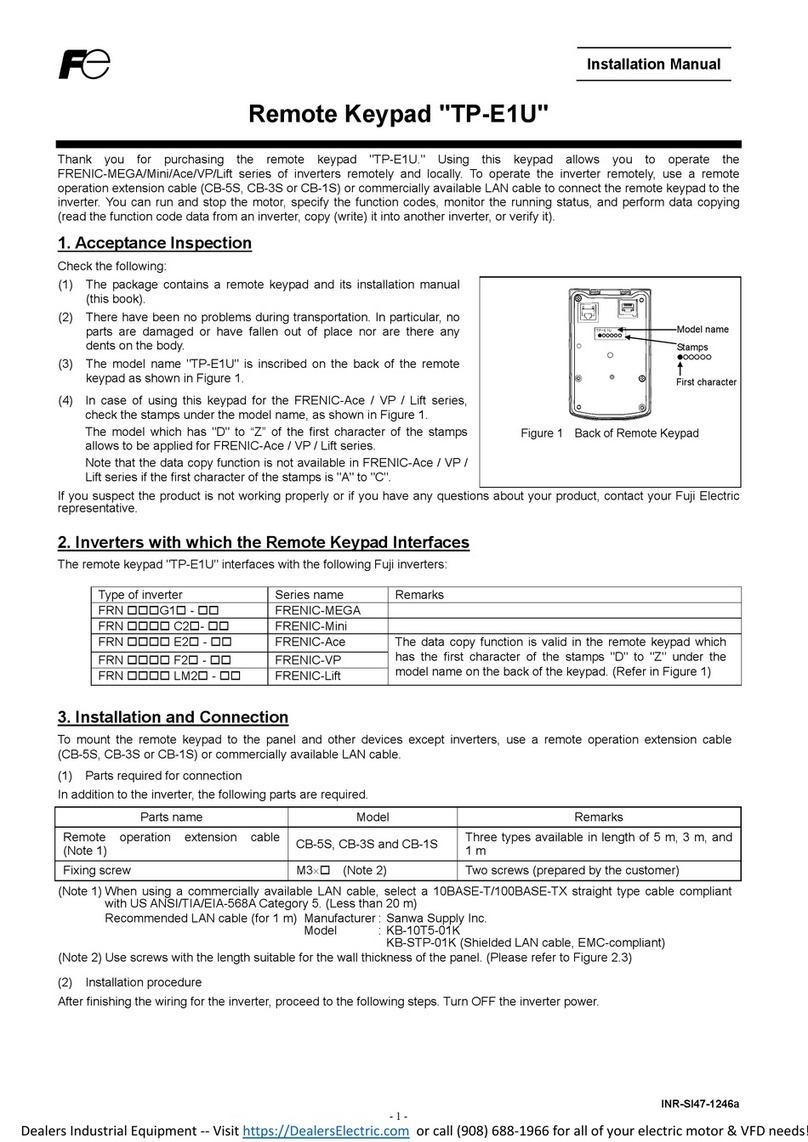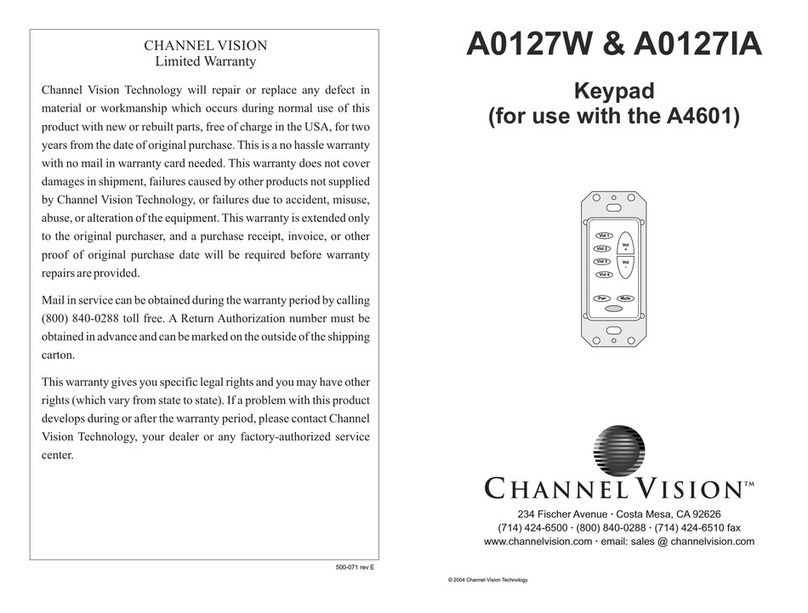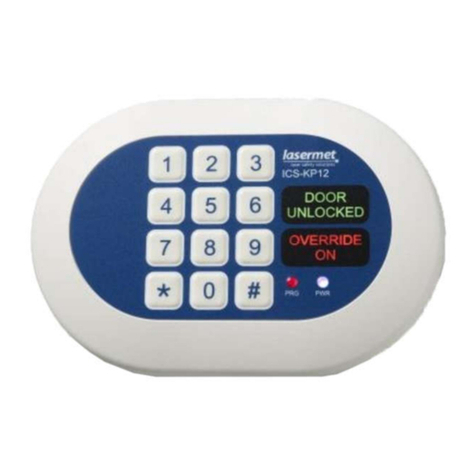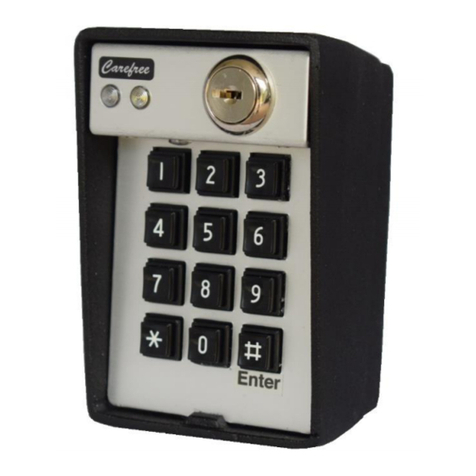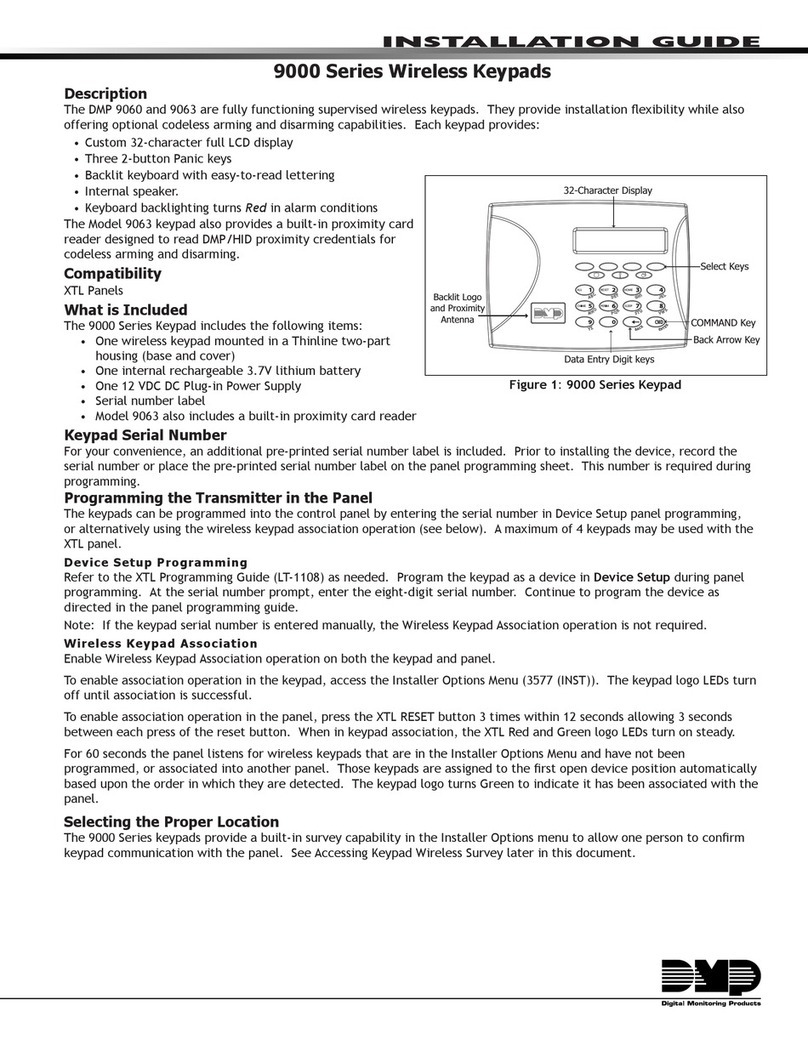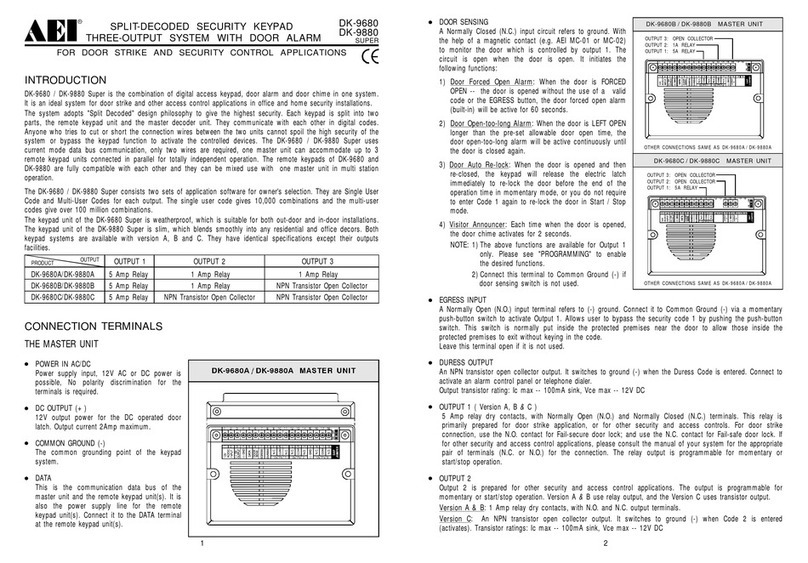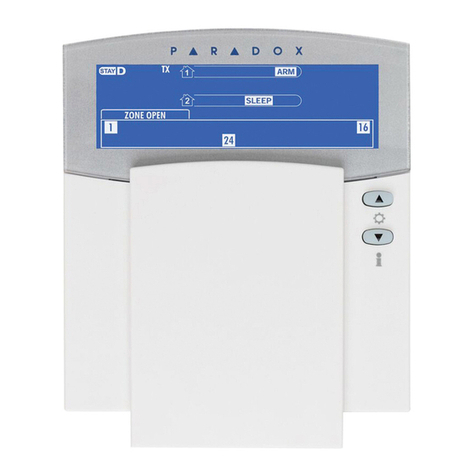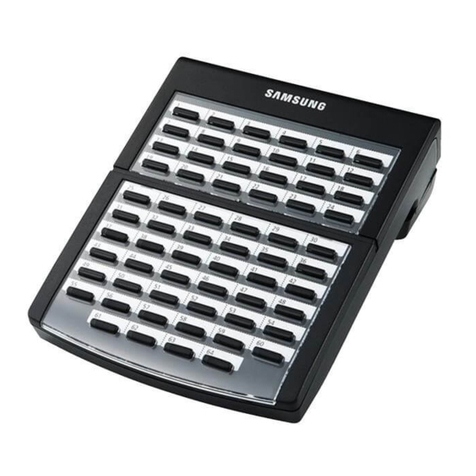FE TP-G1-?LS User manual

Instruction Manual
Multi-function Keypad "TP-G1-LS"
Thank you for purchasing our Multi-function Keypad TP-G1-CLS / TP-G1-ELS.
• This product is designed to remotely control the FRENIC-Lift series of inverters. Read through this
instruction manual and the FRENIC-Lift Instruction Manual, and be familiar with the handling procedure for
correct use.
• Improper handling blocks correct operation or causes a short life or failure.
• Deliver this manual to the end user of the product. Keep this manual in a safe place until the multi-function
keypad is discarded.
• For the usage of inverters and optional equipment, refer to the instruction manuals prepared for the
FRENIC-Lift series of inverters and its optional equipment.
Fuji Electric FA Components & Systems Co., Ltd. INR-SI47-1092b-E

Copyright © 2005 – 2007 Fuji Electric FAComponents & Systems Co., Ltd.
All rights reserved.
No part of this publication may be reproduced or copied without prior written permission from Fuji Electric FA
Components & Systems Co., Ltd.
All products and company names mentioned in this manual are trademarks or registered trademarks of their
respective holders.
The information contained herein is subject to change without prior notice for improvement.

Preface
Thank you for purchasing our multi-function keypad TP-G1-CLS / TP-G1-ELS.
By installing the multi-function keypad directly on a FRENIC-Lift as an attached keypad or connecting them to-
gether using an optional remote operation extension cable(CB-5S, CB-3S, or CB-1S, depending on the distance),
you can operate the inverter locally or remotely. In either mode, you can run and stop the motor, monitor the
running status, and set the function codes. In addition, you can perform "data copying": You can read function
code data from an inverter, copy (write) it into another inverter, or verify it.
Before installing and using the multi-function keypad, read through this manual in conjunction with the
FRENIC-Lift Instruction Manual (INR-SI47-1038-E) and familiarize yourself with its proper use. Improper use may
prevent normal operation or cause a failure or reduced life of the inverter.
The LCD on the multi-function keypad may display each function code name as “FUNCTION.” For the proper
function code name refer to the FRENIC-Lift Instruction Manual (INR-SI47-1038-E) and the FRENIC-Lift Ref-
erence Manual (INR-SI47-1068-E).
Related Publications
Listed below are other publications on the FRENIC-Lift to be consulted in conjunction with this manual as nec-
essary.
• FRENIC-Lift Instruction Manual (INR-SI47-1038-E)
• FRENIC-Lift Reference Manual (INR-SI47-1068-E)
The materials are subject to change without notice. Be sure to obtain the latest editions for use.
About the ROM version of multi-function keypad
Please read manual (INR-SI47-1056-E) when ROM version of a multi-function keypad is 8510. It might be dif-
ferent from the content of the description of this manual.
Please refer to this Manual 3.4.6 Reading maintenance information Menu #5 "Maintenance Information" for the
confirm method of ROM version of multi-function keypad.
Safety precautions
Read this manual thoroughly before proceeding with installation, connections (wiring), operation, or maintenance
and inspection. Ensure you have sound knowledge of the device and familiarize yourself with all safety infor-
mation and precautions before proceeding to operate the inverter.
Safety precautions are classified into the following two categories in this manual.
Failure to heed the information indicated by this symbol may lead to
dangerous conditions, possibly resulting in death or serious bodily injuries.
Failure to heed the information indicated by this symbol may lead to
dangerous conditions, possibly resulting in minor or light bodily injuries
and/or substantial property damage.
Failure to heed the information contained under the CAUTION title can also result in serious consequences.
These safety precautions are of utmost importance and must be observed at all times.
i

Operation
• Be sure to install the terminal block cover and the front cover before turning the power on. Do not re-
move the covers while power is applied.
Otherwise electric shock could occur.
• Do not operate switches/buttons with wet hands.
Doing so could cause electric shock.
• If the retry function has been selected, the inverter may automatically restart and drive the motor de-
pending on the cause of tripping. Design the machinery or equipment so that human safety is ensured
after restarting.
• Never make an alarm reset with the operation signal being on. Doing so will suddenly restart the in-
verter. Ensure that the operation signal is turned off beforehand.
Otherwise an accident could occur.
• If you set the function codes wrongly or without completely understanding this instruction manual, the
FRENIC-Lift Instruction Manual (INR-SI47-1038-E) and the FRENIC-Lift Reference Manual
(INR-SI47-1068-E), the motor may rotate with a torque or at a speed not permitted for the machine.
An accident or injuries could occur.
• Do not touch the inverter terminals while the power is applied to the inverter even if the inverter stops.
Doing so could cause electric shock.
Wiring
• Do not operate the switch with wet hands.
Doing so could cause electric shock.
• Before opening the cover of the inverter to install the multi-function keypad, turn the power off and wait
for at least five minutes. Further, make sure that the LED monitor is turned off, the charger indicator is
off, and the DC link bus voltage between the terminals P (+) and N (-) has dropped below the safe
voltage level (+25 VDC), using a circuit tester or another appropriate instrument.
Otherwise electric shock could occur.
• In general, the insulation property of the sleeve of the signal wire and that of the sheath of the signal
cable are not sufficient for high voltages. Therefore, if a signal wire or cable comes into direct contact
with a live part of the main circuit, the insulation may be broken, causing the signal wire to be exposed to
the high voltage of the main circuit. Be sure to keep all signal wires and cables away from live parts of
the main circuit.
Otherwise, an accident or electric shock could occur.
ii

Disposal
• For disposal, treat the multi-function keypad as industrial waste.
Otherwise injuries could occur.
Others
• Never attempt to modify the multi-function keypad or inverter.
Doing so could cause electric shock or injuries.
GENERAL PRECAUTIONS
Drawings in this manual may be illustrated without covers or safety shields for explanation of detail parts.
Restore the covers and shields in the original state and observe the description in the manual before
starting operation.
How this manual is organized
This manual is made up of chapters 1 through 4
Chapter 1 BEFORE USING THE MULTI-FUNCTION KEYPAD
This chapter describes the points to check upon delivery and lists the inverters the multi-function keypad is de-
signed to interface with.
Chapter 2 INSTALLATION AND INTERCONNECTION
This chapter describes how to install the multi-function keypad and how to interconnect it with an inverter.
Chapter 3 OPERATION USING THE MULTI-FUNCTION KEYPAD
This chapter describes the operation of the inverter using the multi-function keypad. More specifically, this
chapter gives an overview of the inverter’s three operation modes (Running, Programming, and Alarm modes)
and describes how to run and stop the inverter/motor, set function code data, monitor running status, view
maintenance information and alarm data, and perform data copying.
Chapter 4 SPECIFICATIONS
This chapter lists the general specifications such as operating environments, communication specifications and
transmission specifications.
Icons
The following icons are used throughout this manual.
This icon indicates information which, if not heeded, can result in the product not operating to full effi-
ciency, as well as information concerning incorrect operations and settings which can result in accidents.
This icon indicates information that can prove handy when performing certain settings or operations.
This icon indicates a reference to more detailed information.
iii

Table of Contents
Preface ........................................................................i
Safety precautions..............................................................i
How this manual is organized..............................................iii
Chapter 1 BEFORE USING THE MULTI-FUNCTION
KEYPAD.........................................................1-1
1.1 Acceptance Inspection...........................................1-1
1.2 Inverters with which the Multi-function Keypad
Interfaces taka....................................................... 1-1
Chapter 2 INSTALLATION AND INTERCONNECTION.. 2-1
2.1 Accessories and Parts Required for
Interconnection......................................................2-1
2.2 Installing the Multi-function Keypad.......................2-2
2.2.1 Three ways of installation/use.......................2-2
2.2.2 Installing the multi-function keypad............... 2-3
Chapter 3 OPERATION USING THE MULTI-FUNCTION
KEYPAD.........................................................3-1
3.1 Components on the Keypad ..................................3-1
3.2 Overview of Operation Modes...............................3-4
3.3 Running Mode.......................................................3-5
3.3.1 Running/stopping the motor.............................3-5
3.3.2 Setting the reference speed (pre-ramp)........... 3-7
3.3.3 Monitoring the running status
on the LED monitor.......................................3-8
3.4 Programming Mode...............................................3-9
3.4.1 Setting function codes
-- Menu #1 "Data Setting" --........................3-10
3.4.2 Setting up function codes quickly
-- Menu #0 "Quick Setup" --........................3-13
3.4.3 Checking changed function codes
-- Menu #2 "Data Checking" --...................3-13
3.4.4 Monitoring the running status
-- Menu #3 "Drive Monitoring" --..................3-14
3.4.5 Checking I/O signal status
-- Menu #4 "I/O Checking" --.......................3-16
3.4.6 Reading maintenance information
-- Menu #5 "Maintenance Information" -- .... 3-20
3.4.7 Reading alarm information
-- Menu #6 "Alarm Information" --................3-23
3.4.8 Viewing cause of alarm
-- Menu #7 "Alarm Cause" --.......................3-26
3.4.9 Data copying
-- Menu #8 "Data Copying" --......................3-28
3.4.10 Measuring load factor
-- Menu #9 "Load Factor Measurement" --..3-35
3.4.11 Changing function codes covered by Quick setup
-- Menu #10 "User Setting" --......................3-38
3.4.12 Performing communication debugging
-- Menu #11 "Communication Debugging" --3-39
3.5 Alarm Mode.........................................................3-40
3.6 Other Notes.........................................................3-42
3.6.1 Tuning motor parameters...............................3-42
3.6.2 Password protection...................................... 3-44
3.6.3 Connecting to other inverter series................3-47
Chapter 4 ...............................SPECIFICATIONS...................................................................................
4.1 General Specifications...........................................4-1
4.2 Communication Specifications...............................4-2
4.3 Transmission Specifications...................................4-2
iv

Chapter 1 BEFORE USING THE MULTI-FUNCTION KEYPAD
1.1 Acceptance Inspection
Unpack the package and check the following:
(1) The package contains a multi-function keypad and the
following attached goods.
Attached goods
Multi-function keypad fixing screws
Instruction manual (this book)
(2) There have been no problems during transportation. In
particular, no parts are damaged or have fallen out of place
nor are there any dents on the body.
(3) The model name "TP-G1-CLS" or "TP-G1-ELS" is printed on
the back of the multi-function keypad as shown in Figure 1.1.
The language that can be displayed is different in each model
name.(Refer to the table below)
Model name Language that can be displayed
TP-G1-CLS Chinese, English, Japanese
TP-G1-ELS English, Japanese, German, French
Spanish, Italian
If you suspect the product is not working properly or if you have
any questions about your product, contact your Fuji Electric
representative.
Figure 1.1 Back of Multi-function Keypad
TP-G1-CLS / TP-G1-ELS
1.2 Inverters with which the Multi-function Keypad Interfaces
The multi-function keypad interfaces with the following Fuji inverters:
Series Type of inverter*Remarks
FRENIC-Lift FRNLM1S-2
FRNLM1S-4
(Each has its meaning as shown below,
represented by an alphanumeric character.)
No restriction is there for use of this product.
* Type of inverter
For the details of the Inverter type identification, refer to the FRENIC-Lift Instruction Manual
(INR-SI47-1038-E), Chapter 1, Section 1.1 "Acceptance Inspection."
1-1

Chapter 2 INSTALLATION AND INTERCONNECTION
2.1 Accessories and Parts Required for Interconnection
To install the multi-function keypad on the enclosure’s panel instead of the inverter, you need the following
accessories and parts:
Accessories/Parts Type or Specifications Remarks
Remote operation extension cable*1CB-5S, CB-3S, or CB-1S You have a choice of three lengths: 5 m, 3
m, and 1 m.
Screws
(for mounting the multi-function keypad) M3 x *2Provide 2 screws (to be provided by the
customer) beforehand.
*1: Alternatively, you can use an off-the-shelf 10BASE-T/100BASE-TX LAN cable (straight type) that meets the
ANSI/TIA/EIA-568A Category 5 standard (maximum length: 20 m).
Recommended LAN cable:
Manufacturer:Sanwa Supply, Co. Ltd.
Model:KB-10T5-01K (for 1 m)
KB-STP-01K (for 1 m) (shielded cable, EMC-compliant)
*2: Use the screws of the length just right for the panel. (See Figure 2.7.)
2-1

2.2 Installing the Multi-function Keypad
2.2.1 Three ways of installation/use
You can install the multi-function keypad in one of the following three ways:
Install it directly on the inverter (see Figure 2.1).
Install it on the front panel of enclosure (see Figure 2.2).
Use it remotely in your hand (see Figure 2.3).
For FRN□□□LM1S-4□
Figure 2.1 Installing Multi-function Keypad Directly on Inverter
Figure 2.2 Installing Multi-function Keypad on Enclosure Figure 2.3 Using Multi-function Keypad
remotely in Your Hand
2-2

2.2.2 Installing the multi-function keypad
After completion of interconnection, follow the next steps to install the multi-function keypad in place. Be sure to
turn off the power of the inverter beforehand.
Installing the multi-function keypad directly on the inverter
Remove the blind cover mounted on the inverter.
Pull the blind cover toward you while holding down the hook (as directed by the arrows in Figure 2.4
below).
Figure 2.4 Removing the Blind Cover
Mount the multi-function keypad onto the inverter.
Put the multi-function keypad in the original slot while engaging its bottom latches with the holes (as shown
below), and push it onto the case of the inverter (arrow ) while holding it downward (against the terminal
block cover) (arrow ).
Figure 2.5 Mounting the Multi-function Keypad
2-3

Protection from abnormal vibration: for inverters with capacity of 22 kW or less
In an environment with large ambient vibrations, the inverter may be exposed to them, causing abnormal
vibrations on the multi-function keypad. If this happens, remove the terminal block cover and the front cover,
then secure the multi-function keypad to the inverter with the attached screw (Two). After that, reinstall those
covers.
For the procedures for removing the covers, refer to the FRENIC-Lift Instruction Manual
(INR-SI47-1038-E), Chapter 2, Section 2.3.1 "Removing and mounting the terminal block (TB) cover and
the front cover."
Figure 2.6 Fixing the Multi-function Keypad
2-4

Installing the multi-function keypad on the enclosure panel
Cut the panel out for a single square area and perforate two screw holes in the panel of the enclosure as
shown in Figure 2.7.
Model name
Figure 2.7 Dimensions of Square Cut-out and Screw Holes
2-5

Mount the multi-function keypad onto the enclosure with 2 screws as shown in Figure 2.8. (Recommended
tightening torque: 0.7 N•m)
Figure 2.8 Mounting Multi-function Keypad
Remove the blind cover mounted on the inverter (see Figure 2.4) and, using a remote operation extension
cable or a LAN cable, interconnect the multi-function keypad and the inverter (insert one end of the cable
into the RS485 port with RJ-45 connector on the multi-function keypad and the other end into that on the
inverter) (See Figure 2.9.).
Figure 2.9 Connecting Multi-function Keypad to the Inverter with Remote
Operation Extension Cable or an off-the-shelf LAN Cable
Using the multi-function keypad in hand
Follow step of "Installing the multi-function keypad on the enclosure panel" above.
2-6

Chapter 3 OPERATION USING THE MULTI-FUNCTION KEYPAD
3.1 Components on the Keypad
The keypad allows you to start and stop the motor, view various data including maintenance information and
alarm information, set function codes, monitor I/O signal status, copy data, and calculate the load factor.
7-segment
LED monitor
Program key
Indicator indexes
DOWN key
Stop key
UP key Function/Data key
Run forward key
Run reverse key
Reset key
Shift key
Remote/Local
key
LED indicator
LCD monitor
3-1

Table 3.1 Overview of Keypad Functions
Item Monitors and Keys Functions
Five-digit, 7-segment LED monitor which displays the following according to the
operation modes:
In Running mode: Running status information (reference speed (final),
output current and voltage, etc.)
In Programming mode: Same as above.
In Alarm mode: Alarm code, which identifies the cause of an alarm if
the protective function is activated.
LCD monitor which displays the following according to the operation modes:
In Running mode: Running status information
In Programming mode: Menus, function codes and their data
In Alarm mode: Alarm code, which identifies the cause of an alarm if
the protective function is activated.
7-segment
LED
monitor
and LCD
monitor
In Running mode, these indexes show the unit of the number displayed on the
7-segment LED monitor and the running status information on the LCD monitor.
For details, see the next page.
Indicator indexes
Switches the operation modes of the inverter.
Shifts the cursor to the right when entering a number.
Pressing this key after removing the cause of an alarm will switch the inverter to
Running mode.
This key is used to reset settings or screen transition.
UP and DOWN keys. These keys are used to select the setting items or change
the function code data.
and
Program-
ming keys Function/Data key. This key switches the operation as follows:
In Running mode: Pressing this key switches the information to be
displayed concerning the status of the inverter
(reference speed (final), output current and voltage,
etc.).
In Programming mode: Pressing this key displays the function code and
establishes the newly entered data.
In Alarm mode: Pressing this key displays the details of the problem
indicated by the alarm code that has appeared on the
LED monitor.
Starts running the motor in the forward direction. (in local mode only).
Starts running the motor in the reverse direction. (in local mode only).
Stops the motor. (in local mode only)
Operation
keys
Holding down this key for more than 1 second toggles between Local and Remote
modes.
LED
indicator Lights while a run command is supplied to the inverter.
3-2

Items Displayed on LED Indicators
Type Symbol Information, Condition, and Status
Reference speed (final)*1and reference speed (pre-ramp) *1Hz
A Output current
V Output voltage
% Reference torque, reference torque bias, torque bias balance adjustment
value and torque bias gain adjustment value
Reference speed (final)*1, reference speed (pre-ramp) *1 and motor speedr/min
m/min Reference speed (final)*1, reference speed (pre-ramp) *1 and elevator speed
kW Input power
Unit of number
displayed on
LED monitor
X10 Data exceeding 99,999
min Not applicable
sec Not applicable
PID Torque bias balance adjustment and torque bias gain adjustment.
FWD Running in forward direction
REV Running in reverse direction
Running status
STOP Stopped state (No output or detected speed “0”)
REM Remote mode
LOC Local mode
COMM Via communication (RS485-1, CAN)
JOG Jogging mode
Run command
source
HAND Via keypad (Lights also in local mode)
*1Function code C21 provides a choice of units--r/min, m/min, and Hz.
The speed-frequency conversion formulas are given below.
P01
[Hz]
×120×
F03
L31
=[m/min]
P01
[Hz]
×120=[r/min]
3-3

3.2 Overview of Operation Modes
FRENIC-Lift features the following three operation modes:
Running mode: This mode allows you to enter run/stop commands in regular operation. You can also
monitor the running status in real time.
Programming mode: This mode allows you to set function code data and check a variety of information
relating to the inverter status and maintenance.
Alarm mode: If an alarm condition arises, the inverter automatically enters the Alarm mode. In this
mode, you can view the corresponding alarm code* and its related information on the
LED and LCD monitors.
Alarm code represents the type of alarms that have been triggered by the protection function. For details, refer to
the FRENIC-Lift Instruction Manual (INR-SI47-1038-E), Chapter 8, Section 8.5 "Protection Features."
Figure 3.1 shows the status transition of the inverter between these three operation modes.
Figure 3.1 Status Transition between Operation Modes
3-4

3.3 Running Mode
When the inverter is turned on, it automatically enters Running mode. In Running mode, you can:
[ 1 ] Run or stop the motor (in local mode only),
[ 2 ] Set the reference speed (pre-ramp) (in local mode only), and
[ 3 ] Monitor the running status (e.g., reference speed (final), output current, etc.)
3.3.1 Running/stopping the motor
In local mode, pressing the or key starts running the motor in the forward or reverse direction,
respectively. Pressing the key decelerates the motor to stop. This keypad operation is enabled only in
Running and Programming modes.
Figure 3.2 Rotational Direction of Motor
Note) The rotational direction of IEC-compliant motor is opposite to the one shown here.
Displaying the running status on the LCD monitor
When function code E45 data (LCD monitor item selection) is set to "0"
(1)
The LCD monitor displays the running status, the rotational direction, and the operation guide.
(The lower indicators show the running status and run command source. For the upper ones, see Section
3.3.3.)
Figure 3.3 Display of Running Status
The running status and the rotational direction are displayed as listed in Table 3.2.
Table 3.2 Running Status and Rotational Direction
Status/Direction Display Meaning
RUN A run command is present or the inverter is driving the motor.
Running status STOP A run command is not present and the inverter is stopped.
FWD Forward rotation being commanded.
Rotational direction REV Reverse rotation being commanded.
Blank The inverter is stopped (output shut down) or running at zero speed.
3-5

(2) When function code E45 data (LCD monitor item selection) is set to "1"
The LCD monitor displays the reference speed (final), output current, and reference torque in a bar chart.
(The lower indicators show the running status and run command source. For the upper ones, see Section
3.3.3.)
The full scale (maximum value) for each item is as follows:
Reference speed (final): Maximum speed
Output current: 200% of inverter rated current
Reference torque: 200% of motor rated torque
Figure 3.4 Bar Chart
Switching between remote and local modes
The inverter can be operated either in remote or local mode. In remote mode, which applies to normal operation,
the inverter is driven under the control of the data settings stored in the inverter, whereas in local mode, which
applies to maintenance operation, it is separated from the control system and is driven manually under the
control of the keypad.
•Remote mode: The run and speed command sources are determined by source switching signals including
function codes and communications link operation signal. The keypad cannot be used as a
command source.
•Local mode: The keypad is enabled as a run and speed command source, regardless of the settings
specified by function codes. The keypad takes precedence over a communications link
operation signal or other command sources.
Holding down the key for at least one second switches between remote and local modes. Switching to
remote mode turns on the lower indicator above the REM index, and switching to local mode, above the LOC
index.
When the mode is switched from remote to local, the reference speed (pre-ramp) specified in remote mode is
automatically inherited. Further, if the run command is ON at the time of the switching, the inverter automatically
turns on such a run command in the keypad that carries over the rotational direction.
Figure 3.5 Transition between Remote and Local Modes
In local mode, operation (such as issuing run or speed command) on the remote side is disabled. Do not switch from
remote to local mode while the motor is loaded.
Accidents or injuries may result.
3-6

3.3.2 Setting the reference speed (pre-ramp)
You can set the reference speed (pre-ramp) in frequency (Hz) with the / keys on the keypad in local
mode.
Using / keys in local mode
/
(1) Switch the keypad to Running mode. This is because in Programming or Alarm mode, the keys
are disabled to set the reference speed (pre-ramp).
(2) Press the / keys to display the reference speed (pre-ramp) on the LCD monitor with the lowermost
digit blinking.
Figure 3.6 Setting the Speed Command in Local Mode
(3) The newly specified speed is not automatically saved in the inverter, so specify the speed again if necessary
when you restart the inverter.
•When the speed monitor is selected (E43 = 0), the reference speed (pre-ramp) can be specified
with the
/ keys.
•E48 specifies the speed-monitoring formats (unit). For details about the LED monitor, refer to
Section 3.3.3.
•When you start accessing the reference speed (pre-ramp) with the / keys, the lowest digit
on the display will blink and start changing. As you are holding down the key, blinking will gradually
move to the upper digit places and the upper digits will be changeable.
•Pressing the key moves the changeable digit place (blinking) and thus allows you to change
upper digits easily.
Table 3.3 Available Speed Command Sources
Symbol Command source Symbol Command source
HAND Keypad MULTI Multistep speed command
Analog speed command
(Not reversible) Analog speed command
(Reversible)
ANALOGNR ANALOG_R
RS485-1 Via RS485 communications link LOADER Via FRENIC Loader
JOG Jogging operation CAN Via CAN communications link
3-7
This manual suits for next models
2
Table of contents
Other FE Keypad manuals
Popular Keypad manuals by other brands

Upgrading everyday security
Upgrading everyday security EL-2620 introduction
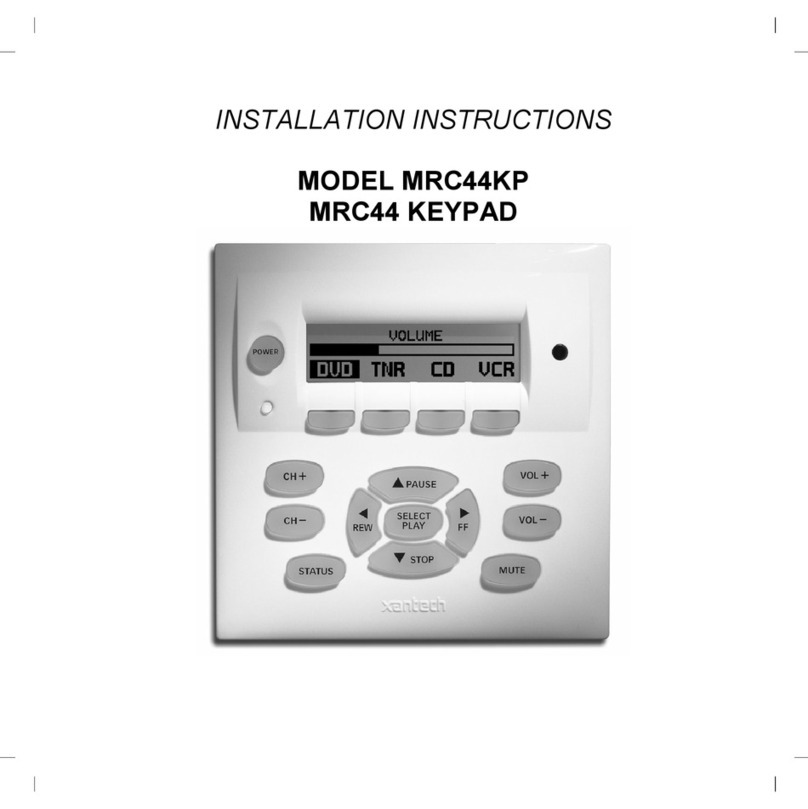
Xantech
Xantech MRC44KP installation instructions
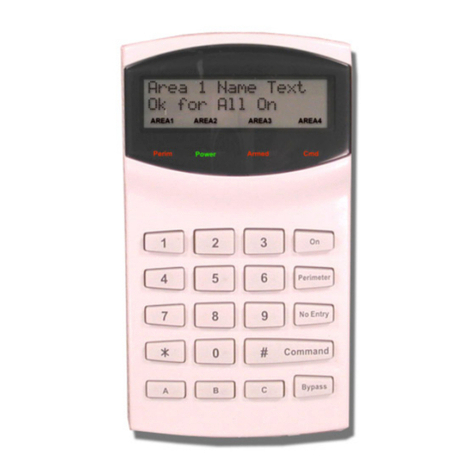
Bosch
Bosch DS7446KP user guide
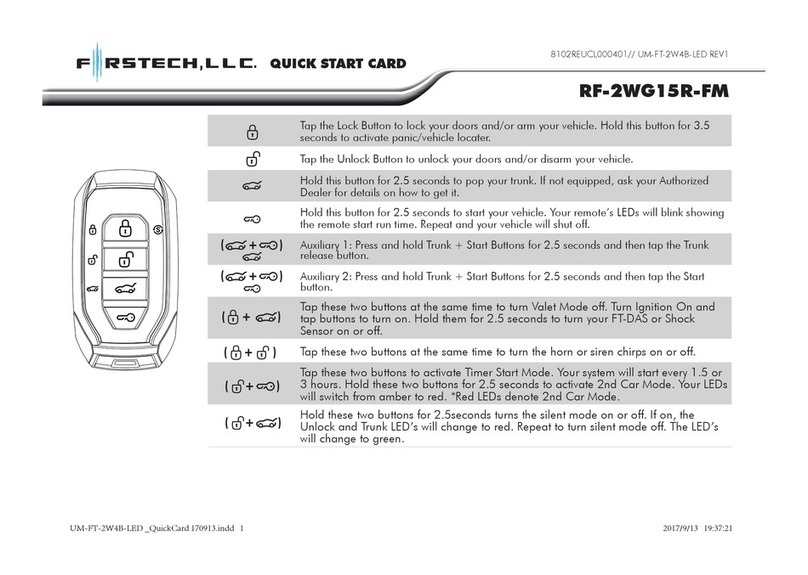
CompuSTAR
CompuSTAR RF-2WG15R-FM Quick start card

Alarm Controls Corporation
Alarm Controls Corporation KP-100 operating instructions
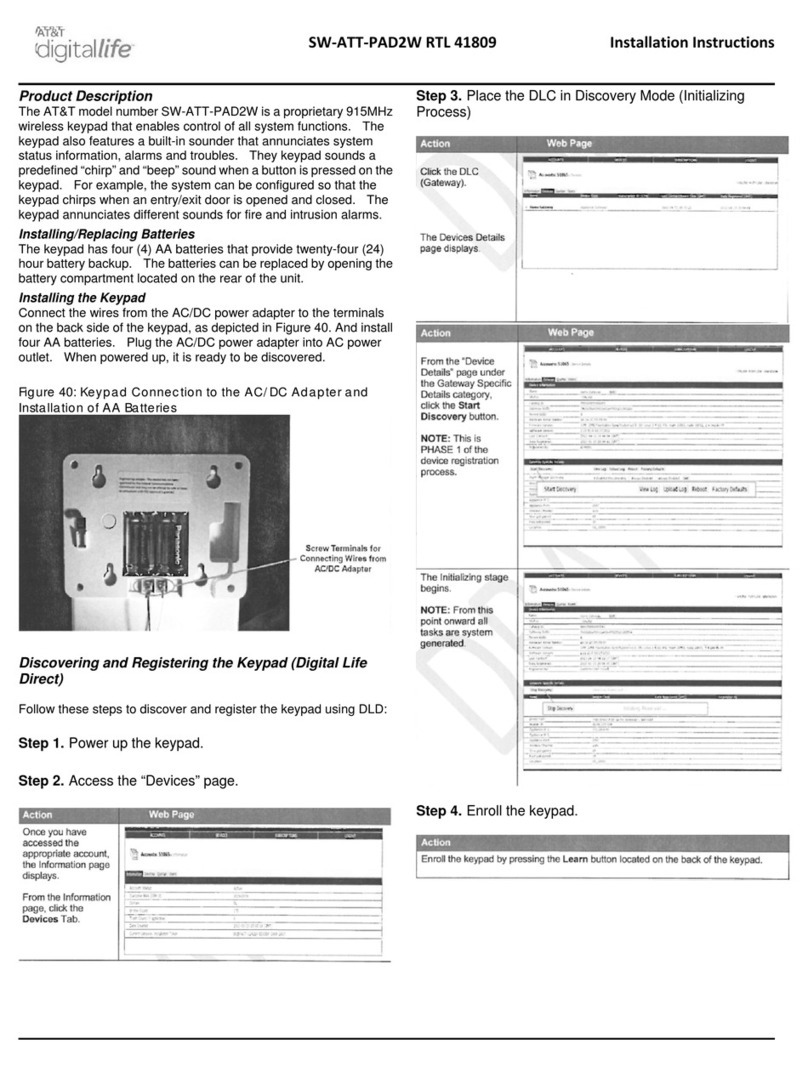
AT&T
AT&T Digital Life SW-ATT-PAD2W installation instructions
